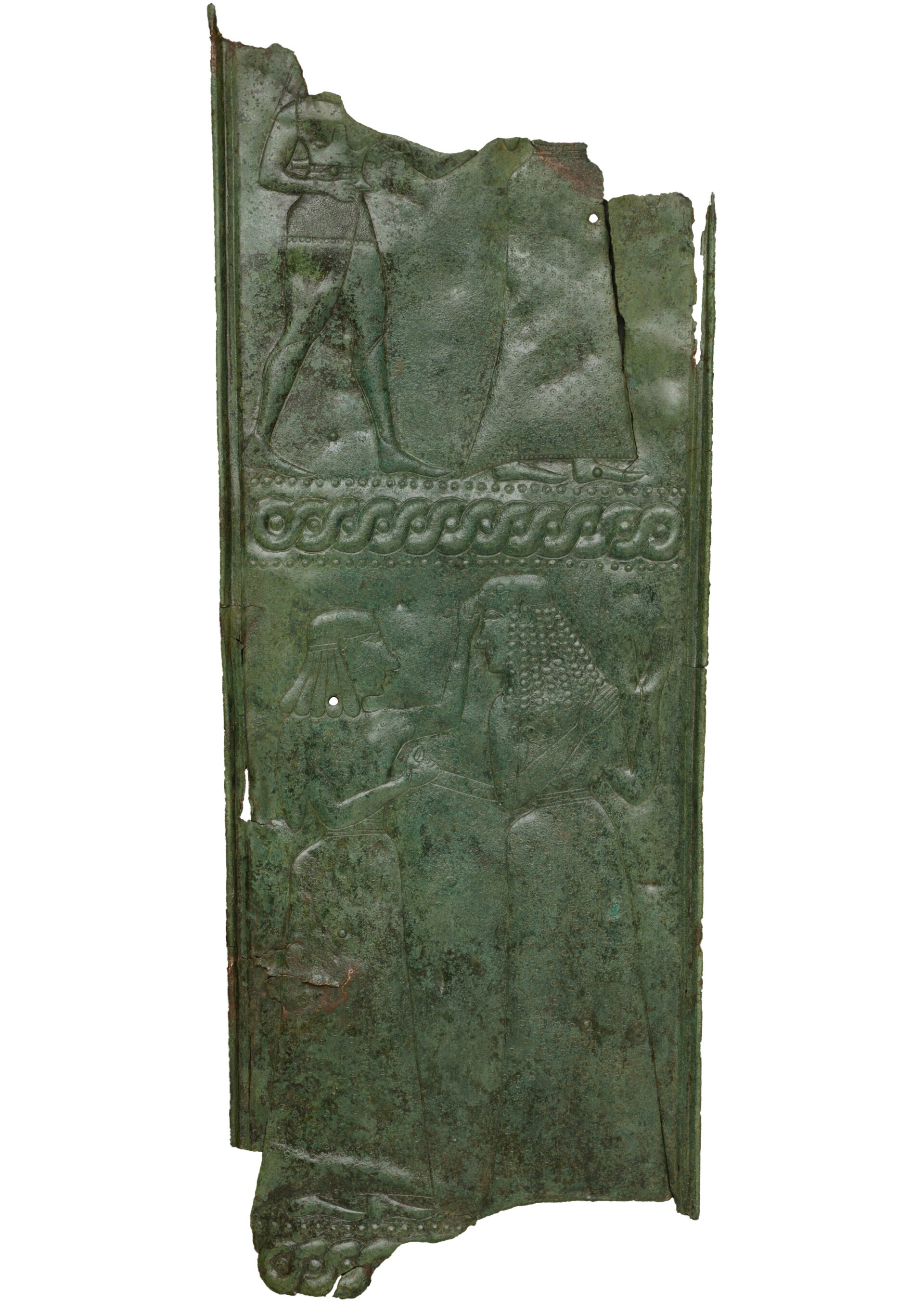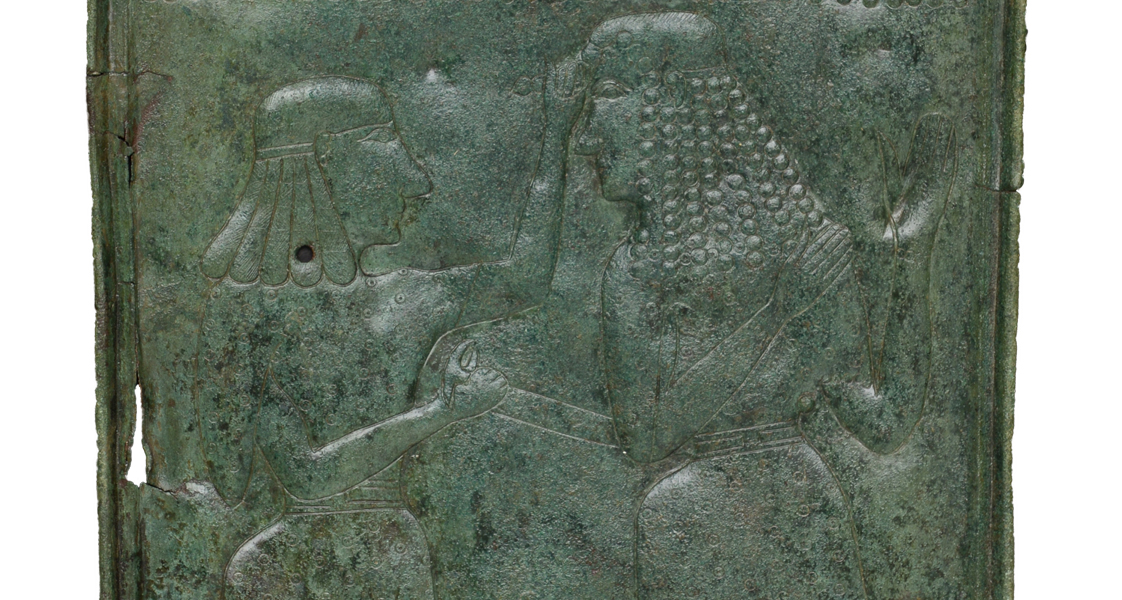Exhibit of the month
Crime and betrayal
Bronze sheet decorated in low relief (repoussé technique)
Νational Archaeological Museum, Metalwork Collection
Inv.no.: Χ 15131
Provenance: Among the findings of a small archaic sanctuary on a hill northwest of Heraion of Argos.
Dimensions: total height: 0,463m., width: 0,169 m.. height of the lower scene: 0,235m.
Dating: 675-650 BC
Display location: Metalwork Collection, Room 52, Showcase 51
The upper and the lower part of the sheet are missing. The sheet’s shape and the nail holes visible in many places, led to the conclusion that it is a revetment of the wooden surface of a piece of furniture or chest (Blegen 1926: 415, Vokotopoulou 1997: 224), or a sheathing of a bronze tripod (Blegen 1926: 415, Walter-Karydi 2008: 21). A scene is depicted in long and narrow registers, divided by a horizontal guilloche flanked by rows of dots, in low relief with delicately incised outlines of the figures and their details. On the fragmentary upper register, a warrior wearing cuirass, shins, helmet and holding a sword follows a woman. On the lower register, two female figures are depicted in the Daedalic style. Their body is rendered almost frontally, while the head and limbs in profile. They both wear belted peplos’ with round ornaments. Incised diagonal lines adorn the hair of the left figure, round hairlocks render the hair of the right figure. The taller, slender woman turns her head back while walking to the right, raising her hands in a gesture of supplication or even terror, as she accepts in her body the dagger that the other woman relentlessly sinks, grabbing her resolutely by the hair. Clytemnestra is probably depicted killing Cassandra, the daughter of King Priam and Hecuba, whom Agamemnon brought as love booty from Troy.
This is one of the earliest depictions of a theme from the mythological circle of the Atreides. As some scholars suggest, the upper register depicts the arrival of the victorious commander Agamemnon and the hostage Cassandra, while the slaying of Agamemnon by Aegisthus and Clytemnestra could occupy the lower part of the sheet, not surviving today. The scenes were therefore related and formed a single narrative composition, forged by a skilled metal craftsman of an Argive or Corinthian (Blegen, 1939: 418, Karouzos 1981: 52) or an island workshop of the early Archaic Period (Walter-Karydi 2008: 21, Herrmann 1980: 86).
This scene of darkness, hatred, violence and erotic revenge is described in ancient Greek epic and drama poetry in a similarly illustrative way and mainly with a penetrating look at human emotion, which is not reflected as an expressive medium in the art of the time of this rare bronze artifact. According to the Homeric version, Clytemnestra, the passion-blinded queen, kills Cassandra mercilessly next to Agamemnon, while he is dying from the sword of Aegisthus and hears the tearing voice of his Trojan slave mistress[1].
In the tragedy “Agamemnon” by Aeschylus (458 BC), who probably follows Pindar (Pyth. 11.17 BC) and the earlier poet Stesichorus (7th-6th century BC), is described the reception of the triumphant king in Argos, his murder, as well as the murder of Cassandra, who has already prophesied their end[2]. The murder was planned and carried out by Clytemnestra, while Aegisthus, claimant to the throne, devised a plan of death taking revenge for the murder of his brothers by Atreus, father of Agamemnon. Motivations for Clytemnestra were the sacrifice of her daughter Iphigenia, which Agamemnon performed without much hesitation, her love for Aegisthus, and Agamemnon’s infidelity with Cassandra[3].
A mythical story about people of royal descent, who act motivated by their passions, violating divine and human laws. How real was the myth at its core? We do not know. But we know how durable it is over time, as much as the copper that withstands the craftsman’s pounding.
[1] But the most piteous cry that I heard was that of the daughter of Priam, Cassandra, whom guileful Clytemnestra slew by my side. And I sought to raise my hands and smite down the murderess, dying though I was, pierced through with the sword.
Homer Odyssey, 11, 421-423
Homer. The Odyssey with an English Translation by A.T. Murray, PH.D. in two volumes. Cambridge, MA., Harvard University Press; London, William Heinemann, Ltd. 1919.
[2] The prophesy of Cassandra is also quoted in the tragedy Trojan Women (415 B.C) by Euripides. Base you are, and basely shall you be buried, in the dead of night when day is done, you captain of that army of Danaids, who think so proudly of your fortune! Yes, and the rocky chasm with its flood of wintry waters shall give my corpse cast forth in nakedness to wild beasts to make their meal upon, near my husband’s tomb, I, Apollo’s servant.
Euripides, The Trojan Women 448-450
Euripides. The Plays of Euripides, translated by E. P. Coleridge. Volume I. London. George Bell and Sons. 1891.
Apollo endowed Cassandra with the gift of infallible division. But when she broke her promise and refused to give in to him, he cursed her that no one should ever believe in her divination, regardless how truth they are.
[3] And here she lies, his captive, and auguress, and concubine, his oracular faithful whore, yet equally familiar with the seamen’s benches. The pair has met no undeserved fate. For he lies thus; while she, who, like a swan, has sung her last lament in death, lies here, his beloved; but to me she has brought for my bed an added relish of delight.
Aeschylus, Agamemnon 1440-1447
Aeschylus. Aeschylus, with an English translation by Herbert Weir Smyth, Ph. D. in two volumes. 2.Agamemnon. Herbert Weir Smyth, Ph. D. Cambridge, MA. Harvard University Press. 1926.
Sapfo Athanasopoulou
Selected bibliography:
Βοκοτοπούλου, Ι. (1997), Αργυρά και χάλκινα έργα τέχνης στην αρχαιότητα, Εκδοτική Αθηνών, 224, αρ. 28.
Καρούζος, Χ. και Καρούζου, Σ. (1981), Ανθολόγημα Θησαυρών του Εθνικού Μουσείου, Έκδοση της Εθνικής Τραπέζης της Ελλάδος, 52, πίν. 47.
Καστριώτης, Π. (1926), ΑΔ (9) Παράρτημα 1926, σ. 4-5.
Blegen, C. (1939), ‘Prosymna: Remains of Post-Mycenaean Date’ AJA 43(1939), pp. 415-418, fig.6.
Herrmann, H.V. (1980), ‘Getriebene Bronzereliefs’, in A. Mallwitz & H.V.
Herrmann (eds), Die Funde aus Olympia, pp. 75-87.
Mason, P. G. (1959), “Kassandra”, The Journal of Hellenic Studies 79, pp.80-93.
Papadopoulou, T. (2000), “Cassandra’s Radiant Vigour and the Ironic Optimism of Euripides Troades”, Mnemosyne 53, 513-527.
Richter, G.(1968), Korai, Archaic Greek Maidens, εικ. 103.
Walter-Karydi, E. (2008), ‘Bronzes pariens et imagerie cycladique du haut archaïsme’, in Y. Kourayos-F. Prost (eds), Actes du colloque organizé par l’Éphorie des Antiquités préhistoriques et classiques des Cyclades et l’ École française d’Athènes, 7-9 Septembre 1998, BCH Suppl. 48(2008), pp. 21-54, fig.1.
Fuchs-S. Floren, Die Griechische Plastik, Band I (1987) σελ. 208, σημ. 20 (με βιβλιογραφία).
Strøm, I. (1998), ‘The Early Sanctuary of the Argive Heraion and its external Relations (8th-Early 6th c. BC.)’, Proceedings of the Danish Institute at Athens, II (1998), pp. 63-67, fig. 24.
Touloupa, E. (1991), ‘Early Bronze Sheets with Figured Scenes from the Acropolis’, in D. Buitron-Oliver (ed.), New Perspectives in Early Greek Art, Studies in the History of Art 32 (1991), p. 241-271, fig. 1-2.



